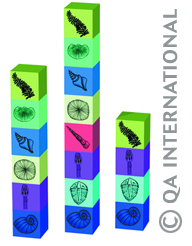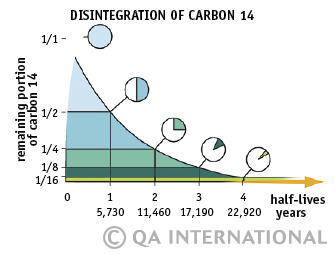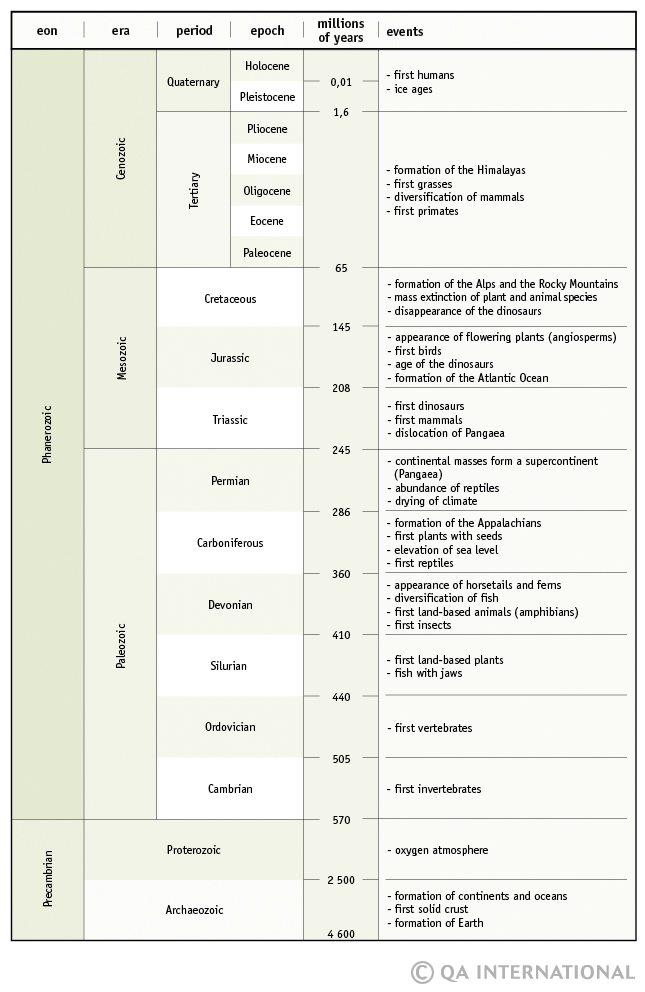Our knowledge of geologic time
How old are the oldest rocks? What was the climate on Earth 300 million years ago? When did aquatic life give way to land-based life? When did birds, conifers, dinosaurs, and flowers appear? One of the great challenges facing geologists is to find answers to such questions. To date a period in the past when there was no written documentation, two methods are used: relative dating and absolute dating. They are based, among other things, on fossils, vestiges of living beings that used to roam the Earth.
The vestiges of time
Fossils, buried under layers of sedimentary rock, are vestiges of the past. They are usually the hard parts (bones, shells, etc.) of animals and plants that have been preserved. Below, an ammonite dies and drops to the bottom of the body of water (1). The mollusk’s body decomposes and sediments begin to cover the shell (2). Over time, the layers of sediment harden and immobilize the shell (3). After millions of years, geologic movements or excavations bring the fossil to the surface (4).

Relative dating
Relative dating (or stratigraphy) is based on using observation of different soil layers to establish a chronological order between various periods. Over time, old sediments are covered with newer sediments, forming an accumulation of layers (or strata) characteristic of a period, with the most recent—in principle—on top. When geologic incidents disturb the strata or upturn them to a vertical position, the principle of paleontologic identity, in which two layers containing the same fossils are from the same period, is used.

Absolute dating
Absolute dating (or radiometry), based on the principle of disintegration of certain radioactive elements, establishes the age of fossils. Carbon 14 (C14) dating is the best known, as carbon is an element found in every living organism. Because organisms contain C14 and C12 in a proportion that is stable and C14 begins to disintegrate at a steady rate when organisms die, the amount of time since a plant or animal has died is measured by establishing the proportion of C14 remaining in relation to the C12.
Scientists have established that it takes 5,730 years before 50% of the C14 has disintegrated. This is called the element’s “half-life.” It would take the same amount of time for half of the remaining material to disintegrate, and so on. Thus, for example, it can be calculated that an organism has been dead 22,920 years when only 1/16 of C14 remains in relation to the C12.
This technique is currently used to date vestiges less than 50,000 years old. Other elements (uranium, rubidium, etc.) are used for older samples.

Geochronology table
Just as historians have divided the history of humankind into different periods, scientists have divided the evolution of Earth into periods corresponding to major changes. Thus, the time since the creation of the planet has been subdivided into intervals called geochronologic units. The largest of these units, eons, are divided into eras, then into periods (or systems) and epochs.

See also:
- "Geology" section in the Visual Dictionary
- "Evolution of life" section in the Visual Dictionary
- "Vegetable kingdom" section in the Visual Dictionary
- "Chemistry" section in the Visual Dictionary




